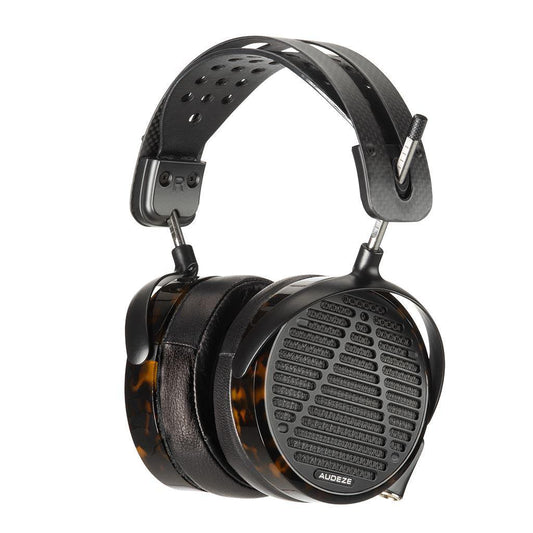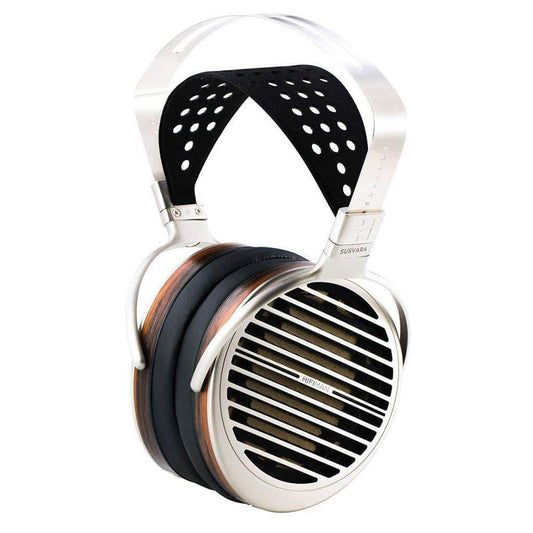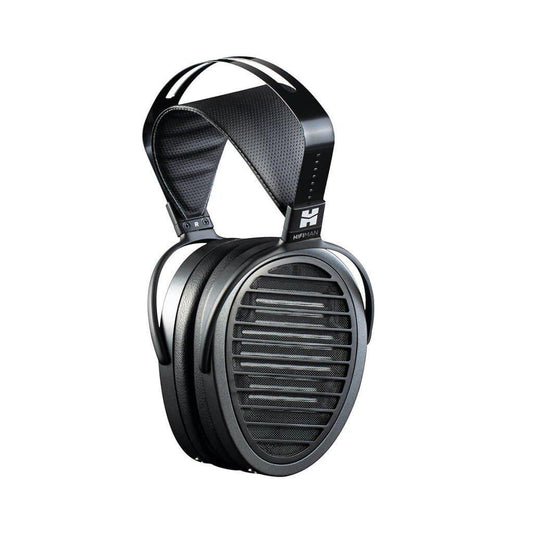CanJam SoCal 2021 Reviewer Roundup

Grover Neville
CanJam Socal 2021 was an unexpectedly busy and active event - I’ve been to a great many of these, and while they’re always very community focused, this one felt particularly human. Covid, new flagships and an exceptional showing of tube amps I think really focused many attendees’ attention towards listening.
Complimenting this was a lot of thoughtful discussion of measurements - I had many great discussions of design concepts and how they relate to what is audible and measurable. Again, I think this was a great companion to all of the tube amps and flagships at the show, many of which have been measured but not extensively heard. Dan Clark of DCA and Justin Weber of Ampsandsound also gave great talks about headphone and amplifier design respectively, and I came away with a lot learned and even more to ruminate further on.
My Highlights - disclaimer that show impressions are made in a noisy environment!

Audeze LCD-5
This is the big one everyone was talking about this weekend, and the Audeze table had a line almost all of both days. I went back a few times to get multiple listens, and I also heard very close to final preproduction versions while at Audeze so while I can’t say definitely until taking one home, but wow! Audeze really knocked it out of the park with this one. Fantastic bass slam and dynamic information, and an almost limitless sense of bandwidth and openness. With the Weiss DAC502 the soundstage really got out of the head and presented a lightning quick and dense but tonally neutral window into the music. I would probably eq up the very low bass because I’m a basshead, but I could actually see leaving it as is. This was my favorite listen of the show. Warmer and less transparent off the Bryston BHA-1 and Chord combo, but still excellent.
It was a curious experience to see so many enthusiasts who had been primed by the published measurements on a major flagship release instead be surprised by what they heard. I suspect this is more because there hasn’t been a large meet or canjam in a while, but my general impression from speaking to other listeners was that they agreed with my take on the 5’s broadly. During the numerous discussions of the LCD-5 this weekend I heard the phrase ‘I didn’t expect it to sound like that from the measurements,’ more times than I can count. I’m excited to see what the broader community impressions and reception are for this headphone.
Audeze LCD-5 Flagship Headphones

Ampsandsound Agartha & Nautilus
After badgering Justin Weber to make a 300B version of his Rockwell amplifier, he modified the Rockwell and revived it with 300Bs as the new Agartha. He gave me a good-natured admonishment - ‘I was frustrated by how good this one sounds!’ he told me when I approached the booth. He handed me a pair of ZMF Verite Closed backs, a headphone I’m intimately familiar with, and I sat down with the Rockwell to get a quick reference before moving on to the Agartha.
While the Rockwell was as enchantingly sweet and pure sounding as I remember it, the Agartha was downright beguiling. The sheer purity of tone, combined with linearity that may surprise you from such an old school design, was unmatched by any other amplifier I heard at the show. This is the magic of good iron and DHTs implemented correctly. Justin’s amps such as the Ovation, which was also at the table typically take their inspiration from the 1950’s and 60’s, but this one takes its inspiration from the 1930’s and 40’s. Powerful, overspecified and with an absence of any harshness or unpleasant textures, these amps are so engaging they represent a reference for musicality. Once you’ve heard DHTs done right, it becomes the standard for enjoyment.
The Nautilus, which has not made a Canjam appearance as far as I know, was also present, and with its gobs and gobs of power - it even gave some dynamic oomph to the otherwise tough to drive DCA Stealth, and drove a pair of JPS Labs Abyss with ease - was surprising a great many solid state fans who were unaware that tube amps could go to such dynamic heights.
Ferrum OOR & Hypsos
I’d seen the press release about Ferrum audio come and go, but it hadn’t made much of an impact. In fact, the team behind this product is also the team behind the Mytek products, or at least had some hand in them. Either way, these are smart folks from Poland, which is having a bit of an audio renaissance at the moment, and these products come from an experienced team.
The small Ferrum OOR and Hypsos look a bit unassuming, but the OOR packs in a mighty 8W a 60 ohms. Susvara owners the show over were talking about this amp quite a bit, and although I didn’t get to try a Susvara on this setup, I did audition the Utopia and LCD-XC 2021 on it, both of which are daily driver headphones for me.
I have to preface my impressions by saying that I have been looking for a headphone amplifier for my studio to surpass my Phonitor XE as a solid state production, mixing and mastering amplifier. The requirements are simple: perfect neutrality with massive dynamics and headroom and a total absence of any harshness or added texture in the treble and bass. Simple enough right? Not quite. Even some of the loftiest solid state headphone amplifiers in the hi-fi realm reveal small pleasing but ultimately distracting characteristics when put into a professional sound production chain.
The Ferrum OOR + Hypsos was the top contender I heard at Canjam however, and an amp I am eagerly hoping to get my hands on for a review. What I heard was the sense of limitless headroom and a soundstage with leapt out of the Utopias effortlessly. Typically these focal headphones have a very narrow and intimate soundstage, yet here they sounded wide, relaxed and enveloping, with every tiny detail in familiar recordings laid bare, yet organized in a musically coherent fashion. Bass was totally controlled and had that ‘just right’ feeling that dismissed any notions of punch versus depth traded away for a texture that was simply appropriate to each track.

Shangri-La Jr. & Susvara
I hadn’t heard many of the recent headphones in HiFiMan’s lineup, so I stopped by their table and tried everything from the HE400SE to the Shangri-La Jr. and I have to say it seems to me that HiFiMan has maybe the highest percentage of really well tuned headphones across their lineup of any headphone maker. Almost everything at the table was solid, barring a few outliers, and the stuff that was really good was exceptionally good. The Susvara presents a huge soundstage and amazing bass impact, along with a slightly relaxed upper midrange that gives the impression of a wide, diffuse spatiality that was quite pleasing. I can see why this headphone is as popular as it is, though I did feel that there was a slight softness to transient peaks that pervaded the entire frequency range. That’s a nitpick though, as this really is an exceptional headphone.
The Shangri-La Jr. is HiFiMan’s more ‘affordable’ - read: less than a fancy car - electrostat that gives you the bass extension that older electrostatics don’t and does away with the aggressive and unpleasant high frequency textures of your grandad’s vintage electrostats. Even tonality, and even some impact made this probably the coolest electrostat I heard at the show. While I don’t plan on buying an electrostatic setup anytime soon, if I was, this would be at the top of my audition list.
Hifiman Susvara Flagship Headphones
Honorable Mentions & Interesting Toys
The RAAL circumaural headphones were interesting, though with a large peak at 6800hz and 12khz rather harsh. However, detail was exceptional and bass was more extended than on the SR1a, and Danny from Requisite Audio tells me that the pads on the circumaural I heard were still in development, and the tuning should improve. He also had a number of gorgeously finished and excellent sounding amplifiers, both solid state and tube that were on display, both stereo and headphone oriented. I think these excited me more than the headphones, though I didn’t get a chance to listen as much as I’d like with familiar headphones.

VZR was at the show, and for $350 these are a very impressive headphone, especially for the bass lovers amongst you. The tuning is is unabashedly bassier, but the very low subbass region is detailed, textured and huge in a way few headphones are. There were a few different earpads available, and I expressed my preferences to the guys at VZR, who were eminently receptive to feedback, and have a solid background doing very interesting spatial and consumer audio work. Don’t be fooled by the gaming moniker. These are a headphone to checkout for sure.
Precogvision
I’m known for being the consummate IEM guy among my peers, so CanJam presented a unique opportunity for me to go outside of my comfort zone and get my ears on some notable headphones. Please bear in mind that listening was done in show conditions which are very, very different from listening from the comfort of one’s own home. The ambient environment was quite loud - and I don’t like to listen loud - which made it difficult for me to get an accurate representation of a given headphone’s performance. I also do not remember the DAC/Amp I used for listening to every headphone. Take these impressions with a grain of salt!

Audeze LCD-5
From what I could tell, these headphones were the star of the show with a never-ending line for them both days. Well, they’re...okay, I guess. The LCD-5 sports very good detail and technicalities as one would expect of the Audeze headphones; the LCD-5 does remind me of the LCD-4 in this regard. Both headphones actually have a good sense of tactility to notes, a sense of micro-texturing, that belies most planar headphones I've heard. But akin to the LCD-4, I don’t think the tonality of the LCD-5 was really to my taste. In any case, I couldn't really discern much because I didn't recognize any of the test tracks available. Hint: More K-pop tracks next time, please!
DCA Stealth
The Stealth sports what I hear as a neutral to slightly upper-midrange oriented tonal balance, one that is surprisingly devoid of any egregious peaks or valleys. Given that every other closed-back headphone that I’ve heard has what I can only describe as undesirable tonality, this is certainly commendable. My biggest criticism of the Stealth, however, would lie in its intangibles. It appears to be circumscribed by the usual flaws that characterize most planar headphones. Detail is no more nuanced than surface-level, dynamics are generally flat for both macro and micro contrast, and the Stealth has the maligned, dry timbre that is the bane of many a planar. Ultimately, while the Stealth definitely has its niche, one would have to index heavily for tonality for it to be a consideration in my eyes.
Focal Utopia
I’ve often heard this headphone described as a Clear on steroids, and I think that’s a pretty fair assessment. The Utopia is more technical and does not have the sibilance issue that I associate with the Clear (that came from the high contrast between the Clear’s upper-midrange and lower-treble). Interestingly, the Utopia does not sound as boxy as the Clear from memory, despite staging seemingly not expanding much further than its younger brother. I was also surprised to find that the timbre on the Utopia is not bad. Perhaps by virtue of the Forge Tube amp that I was listening off of, I only observed some unwanted harshness in the treble. Overall? A remarkably good all-round and with Focal’s signature dynamic contrast.

HiFiMAN Susvara / Shangri-La Jr
These sounded pretty similar to me tonally. But that’s a good thing because, at least to my ears, there are quite honestly no flaws to either of these headphones’ tonal balances. HiFiMAN can definitely tune. My overall impression of the Shangri-La Jr. was that it was somewhat vanilla as a whole, but very solid. In fact, I did not even realize it was an electrostatic headphone until Resolve walked by and mentioned it to me! On the other hand, the Susvara immediately had my attention. It plays at the top for detail, resolution, and imaging. I thought the only aspect with which it fell short was in the dynamics department. But it's not hard to see why the Susvara is often deemed one of the world's best headphones - it makes very few mistakes.
Meze Empyrean
The Empyrean has a very colored sound. It is quite warm and thick with good amounts of mid-bass, but it also sports some spice up top in the treble. The biggest flaw with this headphone's tuning, though, is a strange recession at 1.5kHz. Vocal overdubs on Taeyeon's "Feel so Fine" and a lot of the female vocalists on Sawano Hiroyuki's work sound really telephonic. While I can see why this type of sound might appeal to some listeners, and this recession does benefit center image distinction to some extent, I do feel that these tuning choices negatively impact the Empyrean's ability to resolve detail. It generally sounds somewhat “goopy” for lack of a better word.

Meze Empyrean Elite
The Empyrean Elite is a noticeable improvement over the Empyrean in the technical department, at least in terms of note definition and bass control. The 1.5kHz dip is still present, but not quite to the same degree. I noticed this had a very "boxy" presentation wherein stuff that would normally be at the sides of the stage was squeezed to the center. On the other hand, Resolve tells me he had the opposite impression in terms of staging, so I'm not sure what could account for this. Funnily enough, I only noticed this near the end of my demo session, so perhaps the headphones’ placement on my head shifted egregiously. Anyways, the Empyrean Elite is a decent headphone - just not remarkable for the hefty price.

Photo credits: Den-Fi
PhilPhone
This headphone was the dark horse of the show for me beyond a shred of doubt. The PhilPhone is a DIY headphone made by Zerousen, better known as Phil on various Discord channels. This was my first time hearing a biodynamic and this headphone can slam, oh my. It might just have some of the best bass that I've heard of a headphone with its terrific swing, texture, and bass tactility. I spent about an hour listening to this off of the "slam stack" (DC2/BHA1) and couldn't stop smiling the entire time. The most absurd thing about this headphone (or maybe by virtue of the stack itself) is that it does not distort no matter how much of a juicy bass shelf you add to it. And it's not like the Philphone is just all about bass either. It is beautifully dynamic with some of the best punch and contrast that I have heard. The overall tonality here is also generally good, with the only point of contention being some spikes in the upper-treble. I'm not really in the market for a headphone, but at $700, this is the first one on my list.
Andrew (Resolve)
For me, CanJam (and most events or meetups in general) is more about the people than the gear. There’s a lot of time spent chatting with manufacturers and other enthusiasts. I love learning about the product development process, or new advancements in technology - and equally how the instantiation of that technology is received by listeners on the showfloor. CanJam SoCal 2021 was no different, and I certainly got to do that. But, I was also able to spend time with a variety of equipment over the course of the two days there.
I had mentioned in my previous article that the two standouts for me were the Ampsandsound booth, with a number of Justin’s amplifiers, and also getting to hear the new flagship Audeze LCD-5 . But of course, I got to try out a lot more than just those products, so I’ll cover the rest now - the perennial caveat being that show conditions make it difficult to evaluate anything involving open-back headphones.
HiFiMAN
It may have seemed like a quiet weekend for HiFiMAN, without any major new flagship releases, but they have updated a number of products, some of which I got to try out. What some folks may not know though is that I use both the Susvara and the Shangri-La Jr. at the studio regularly, and at present they’re two of my favorite headphones period. Given that’s the case, I won’t be covering them here.

Deva Pro
While I wasn’t a huge fan of the original Deva’s sound for the price, I did find it to be a compelling if somewhat niche product given its wireless open-back use case. The BlueMini wireless module effectively enabled it to be an open-back wireless planar with a reasonable frequency response. My main complaint however was that it wasn’t technically competitive with HiFiMAN’s other offerings at around its asking price. It makes sense that this driver was then sent off to Drop for the wired HE5XX at a lower price tag. But regardless, HiFiMAN is back at it with the Deva Pro - which includes an evolved wireless module featuring the Himalaya R2R DAC.
My brief time listening to it made me think that while it still had some minor frequency response quirks, the technical performance was at least a bit tighter and more resolving sounding than the original Deva (from memory, so take that for what you will). HiFiMAN has also been using their new ‘stealth magnet’ design for the Deva Pro, and while my investigation into this subject on the HE400se was that it didn’t make much difference there, it'll be interesting to see how the rounded magnets affect the Deva Pro’s sound when compared with the original Deva.
The other interesting thing is the potential application of the wireless module (and the new Himalaya R2R DAC) with HiFiMAN’s other headphones. At the moment it’s only usable with several of them, namely the Deva, Deva Pro and I believe one of the closed-backs that I did not enjoy, but maybe one day we could see them make a high-end open-back with this tech. It’s a cool idea, and from my speculation, it seems like the module approach is the direction they’re going for their wireless headphone designs, instead of what they did with the Ananda-BT (which didn’t work out so great in my opinion).
Arya Stealth Magnet
This seemed to be a very popular product at the show, but I found the Arya to be so open sounding that it was difficult to get a sense of how different it was from the previous version - especially given that I didn’t have one on hand. But, what I can say is that to a large extent it’s a very familiar sound if you’ve heard the previous version. I will be getting one of these in to compare and check the frequency response, but the main thing to consider with the stealth magnet tech in these is that they mainly affect the treble frequencies. And, this is where the show conditions caveat plays a strong role, I honestly don’t know how it’s possible to get a sense of the improvements here, but in general it still sounded quite good to me.
Hifiman Arya Headphones | Stealth Magnets Edition
Raal Requisite
Having heard the SR1a off of the Jotunheim R some time ago, I was curious to try it out of the multitude of Raal stacks at the booth. If anyone hasn’t heard the SR1a, it’s a bit of a wild experience. It’s essentially a ribbon driver ‘ear-speaker’, that doesn’t couple to the side of the head like a typical circumaural headphone would (more on that shortly). Instead it sits in front of the ear with flaps that can be turned outward or inward to change the sound depending on preference. For me, I preferred it with the flaps a bit closed in. In general, my previous assessment of the SR1a is that it was very detailed, but with a bit of glare in the upper mids and lacking in sub-bass. Sure enough, off the Raal stack I heard it from, it did seem to gain quite a bit of body. So that was immediately interesting, but Raal had another product at the show, namely a prototype of their new circumaural headphone the SR2a (I’m not sure if this is the final name?)
In any case, there were a number of folks who got to try this new design, and I think the general takeaway was that while it had more linear bass extension, it was also a bit bright in the upper treble frequencies, and that’s how I heard it as well. But I think what needs to be understood is that the pads weren’t finalized. They didn’t have any material covering them, and I spoke to Danny McKinney of Requisite Audio who indicated that this was still in the works. Changing the material and pad style will make a massive difference to the overall tonal balance. So don’t let any initial impressions of this prototype be the final word on this product.
Other Notable Products
Some of these I’d heard before, but it was interesting getting to check them out again and compare at the show.

T + A Solitaire P
This headphone was brought to the show by a generous attendee who let some of us hear it. For those unaware, the Solitaire P is a rare high-end open back planar magnetic headphone that can be found for around $5500. I got to listen to it off the Forge tube amplifier, and my initial impression is that while there was something a bit strange going on in the treble frequencies, this headphone is very detailed, and has decent dynamics down low as well. It’s definitely something I want to measure on the GRAS and listen to in the studio at some point to get the full assessment.
ZMF Verite Closed
I have of course heard the VC before, but every time I get a chance I like to take it - since this is a closed-back headphone that I don’t normally get to hear. ZMF weren’t at the show, but Zach’s headphones were featured at a number of the booths, and many were trying it at Justin Weber’s Ampsandsound booth to see how it paired with a variety of tube amps.
For me, the VC is one of the top closed-back headphones out there, and I think it’s what I would choose over the Open if it had been available at the time. Keep in mind that I have no idea what the pads were on the VC I tried at the show, I generally found it to be a slightly more balanced presentation overall when compared to the open, even if it still has a similar esoteric 5khz quirk - but boy does it ever slam off the Forge. Another great pairing was of course with the Kenzie Ovation - this was less about the slam and more about that sweetness and midrange focus that this amp seems to impart. But, this yet again reinforced that I need to get a VC in my home listening environment to make a proper assessment.

Dunu Falcon Pro
What a fantastic IEM. For some reason I was originally under the impression that the Falcon Pro was going to be around $300, and I thought to myself after hearing it “yeah that makes sense, this competes with the Blessing 2” albeit with a noticeably warmer presentation. I was then shocked to learn that the Falcon Pro is only $220. Built on Dunu’s Eclipse dynamic driver platform, the Falcon Pro also has three different nozzle configurations you can choose from, with a different presentation for each. My favorite was the default ‘reference’ configuration. But basically, it’s simply a solid tuning overall, with excellent contrast and dynamism throughout. It’s also super comfortable, so I expect this IEM to be very popular.
---



